Unit 1 This is my day说课稿
- 格式:doc
- 大小:33.00 KB
- 文档页数:5
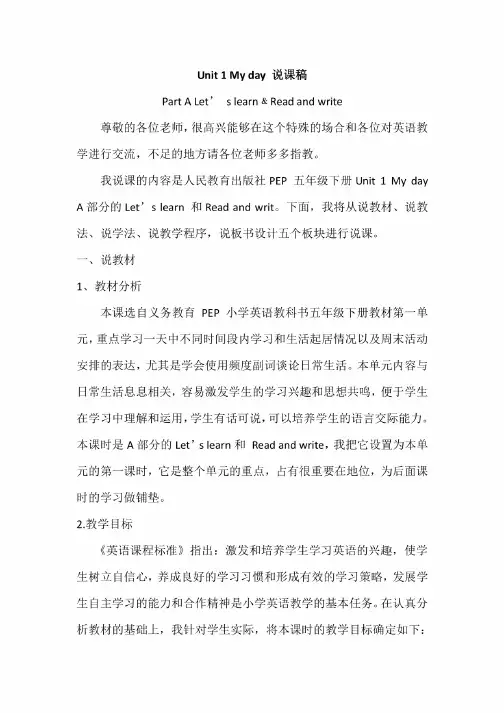
Unit1My day说课稿Part A Let's learn&Read and write尊敬的各位老师,很高兴能够在这个特殊的场合和各位对英语教学进行交流,不足的地方请各位老师多多指教。
我说课的内容是人民教育出版社PEP五年级下册Unit1My day A部分的Let's learn和Read and write下面,我将从说教材、说教法、说学法、说教学程序,说板书设计五个板块进行说课。
一、说教材1、教材分析本课选自义务教育PEP小学英语教科书五年级下册教材第一单元,重点学习一天中不同时间段内学习和生活起居情况以及周末活动安排的表达,尤其是学会使用频度副词谈论日常生活。
本单元内容与日常生活息息相关,容易激发学生的学习兴趣和思想共鸣,便于学生在学习中理解和运用,学生有话可说,可以培养学生的语言交际能力。
本课时是A部分的Let's learn和Read and write,我把它设置为本单元的第一课时,它是整个单元的重点,占有很重要在地位,为后面课时的学习做铺垫。
2.教学目标《英语课程标准》指出:激发和培养学生学习英语的兴趣,使学生树立自信心,养成良好的学习习惯和形成有效的学习策略,发展学生自主学习的能力和合作精神是小学英语教学的基本任务。
在认真分析教材的基础上,我针对学生实际,将本课时的教学目标确定如下:(1)知识目标:能够正确听、说、认读短语:do morning exercises,eat breakfast,have---class,play sports,eat dinner和能够正确听、说、朗读“When do you…?卜®!:…”等询问他人和表达自己作息时间的交际用语。
(2)能力目标:能够听懂、会说句型"When do you…?[•••at…”,并根据实际情况运用所学动词短语表达自己的作息时间。
(3)情感目标:引导学生养成良好的作息习惯。
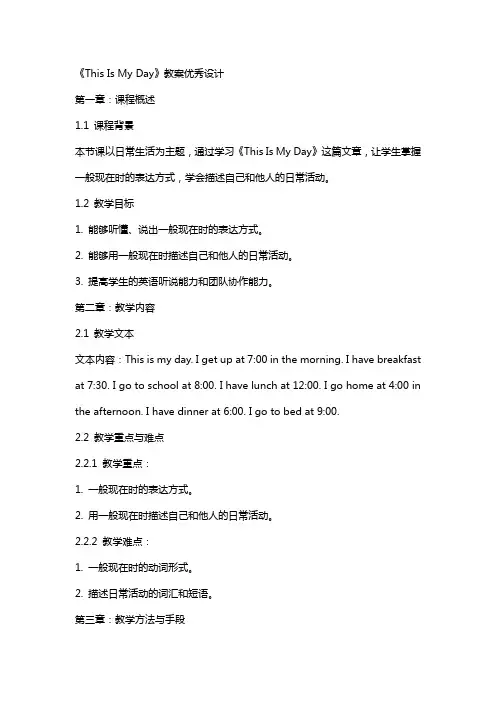
《This Is My Day》教案优秀设计第一章:课程概述1.1 课程背景本节课以日常生活为主题,通过学习《This Is My Day》这篇文章,让学生掌握一般现在时的表达方式,学会描述自己和他人的日常活动。
1.2 教学目标1. 能够听懂、说出一般现在时的表达方式。
2. 能够用一般现在时描述自己和他人的日常活动。
3. 提高学生的英语听说能力和团队协作能力。
第二章:教学内容2.1 教学文本文本内容:This is my day. I get up at 7:00 in the morning. I have breakfast at 7:30. I go to school at 8:00. I have lunch at 12:00. I go home at 4:00 in the afternoon. I have dinner at 6:00. I go to bed at 9:00.2.2 教学重点与难点2.2.1 教学重点:1. 一般现在时的表达方式。
2. 用一般现在时描述自己和他人的日常活动。
2.2.2 教学难点:1. 一般现在时的动词形式。
2. 描述日常活动的词汇和短语。
第三章:教学方法与手段3.1 教学方法1. 任务型教学法:通过完成任务,让学生实践和应用所学知识。
2. 情境教学法:创设生活情境,让学生在实际情境中学习英语。
3. 交际教学法:引导学生进行小组讨论和互动,提高口语表达能力。
3.2 教学手段1. 多媒体教学:利用PPT、视频等教学资源,丰富教学内容。
2. 实物教学:使用日常用品等实物,帮助学生理解和记忆。
第四章:教学过程4.1 导入通过播放一首关于日常活动的英文歌曲,激发学生的学习兴趣,引出本节课的主题。
4.2 展示1. 教师展示PPT,呈现一般现在时的表达方式。
2. 学生跟读并模仿,熟悉一般现在时的动词形式。
4.3 实践1. 学生分组,每组选择一个日常活动,用一般现在时进行描述。

《This Is My Day》教案优秀设计一、教学目标:1. 知识目标:(1)能够听懂、会说、会读本课的生词和重点句子。
(2)能够用英语简单描述自己的一天。
2. 能力目标:(1)能够运用所学知识进行简单的日常交流。
(2)能够用英语完成任务,如描述图片等。
3. 情感目标:(1)培养学生的学习兴趣,激发学生学习英语的积极性。
(2)培养学生热爱生活,珍惜时间的良好品质。
二、教学内容:1. 单词:morning, afternoon, evening, night, breakfast, lunch, dinner, school, home, play, read, watch, TV, puter, sports2. 重点句子:What time is it? It's time for breakfast/lunch/dinner/bedtime.I get up/go to school/e home/have lunch/do my homework/go to bed at I have for breakfast/lunch/dinner.After school, II like I don't like三、教学重点与难点:1. 教学重点:(1)单词:morning, afternoon, evening, night, breakfast, lunch, dinner, school, home, play, read, watch, TV, puter, sports(2)重点句子:What time is it? It's time for breakfast/lunch/dinner/bedtime. I get up/go to school/e home/have lunch/do my homework/go to bed at2. 教学难点:(1)单词:morning, afternoon, evening, night(2)句子:What time is it? It's time for breakfast/lunch/dinner/bedtime.四、教学方法:1. 情境教学法:通过设定日常生活的情境,让学生在真实的环境中学习英语。
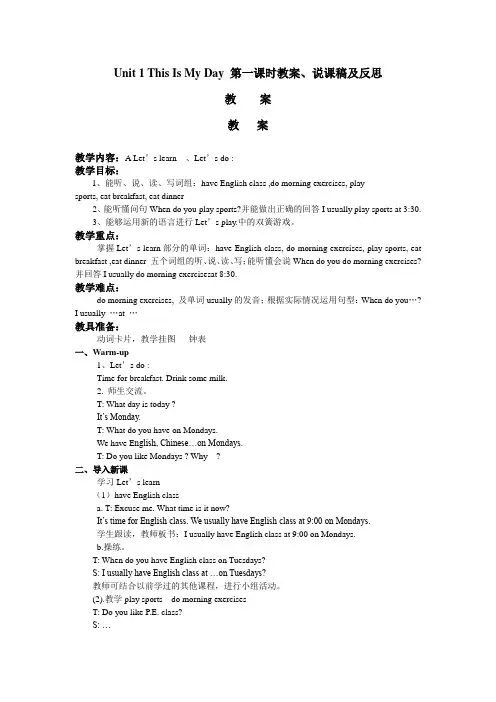
Unit 1 This Is My Day 第一课时教案、说课稿及反思教案教案教学内容:A Let’s learn 、Let’s do :教学目标:1、能听、说、读、写词组:have English class ,do morning exercises, playsports, eat breakfast, eat dinner2、能听懂问句When do you play sports?并能做出正确的回答I usually play sports at 3:30.3、能够运用新的语言进行Let’s play.中的双簧游戏。
教学重点:掌握Let’s learn部分的单词:have English class, do morning exercises, play sports, eat breakfast ,eat dinner 五个词组的听、说、读、写;能听懂会说When do you do morning exercises? 并回答I usually do morning exercisesat 8:30.教学难点:do morning exercises, 及单词usually的发音;根据实际情况运用句型:When do you…?I usually …at …教具准备:动词卡片,教学挂图钟表一、Warm-up1、Let’s do :Time for breakfast. Drink some milk.2. 师生交流。
T: What day is today ?It’s Monday.T: What do you have on Mondays.We have E nglish, Chinese…on Mondays.T: Do you like Mondays ? Why ?二、导入新课学习Let’s learn(1)have English classa. T: Excuse me. What time is it now?It’s time for English class. We usually have English class at 9:00 on Mondays.学生跟读,教师板书:I usually have English class at 9:00 on Mondays.b.操练。
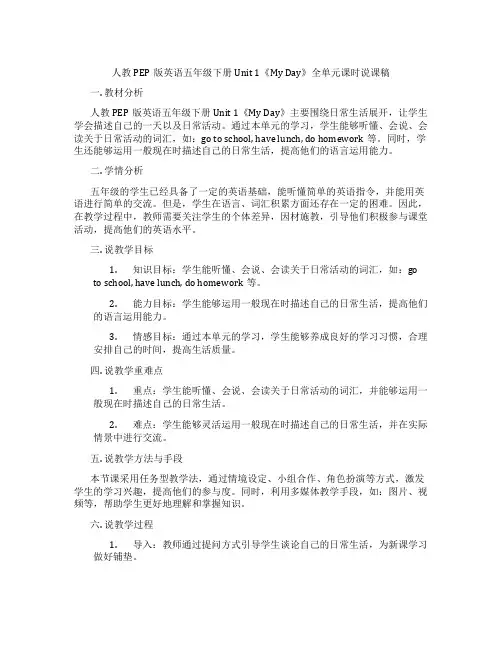
人教PEP版英语五年级下册Unit 1《My Day》全单元课时说课稿一. 教材分析人教PEP版英语五年级下册Unit 1《My Day》主要围绕日常生活展开,让学生学会描述自己的一天以及日常活动。
通过本单元的学习,学生能够听懂、会说、会读关于日常活动的词汇,如:go to school, have lunch, do homework等。
同时,学生还能够运用一般现在时描述自己的日常生活,提高他们的语言运用能力。
二. 学情分析五年级的学生已经具备了一定的英语基础,能听懂简单的英语指令,并能用英语进行简单的交流。
但是,学生在语言、词汇积累方面还存在一定的困难。
因此,在教学过程中,教师需要关注学生的个体差异,因材施教,引导他们积极参与课堂活动,提高他们的英语水平。
三. 说教学目标1.知识目标:学生能听懂、会说、会读关于日常活动的词汇,如:goto school, have lunch, do homework等。
2.能力目标:学生能够运用一般现在时描述自己的日常生活,提高他们的语言运用能力。
3.情感目标:通过本单元的学习,学生能够养成良好的学习习惯,合理安排自己的时间,提高生活质量。
四. 说教学重难点1.重点:学生能听懂、会说、会读关于日常活动的词汇,并能够运用一般现在时描述自己的日常生活。
2.难点:学生能够灵活运用一般现在时描述自己的日常生活,并在实际情景中进行交流。
五. 说教学方法与手段本节课采用任务型教学法,通过情境设定、小组合作、角色扮演等方式,激发学生的学习兴趣,提高他们的参与度。
同时,利用多媒体教学手段,如:图片、视频等,帮助学生更好地理解和掌握知识。
六. 说教学过程1.导入:教师通过提问方式引导学生谈论自己的日常生活,为新课学习做好铺垫。
2.呈现:教师展示教材图片,引导学生说出日常活动词汇,如:go toschool, have lunch, do homework等。
3.学习:教师带领学生学习一般现在时的表达方式,如:I go to schoolevery day.4.实践:学生分组进行角色扮演,运用一般现在时描述自己的日常生活。
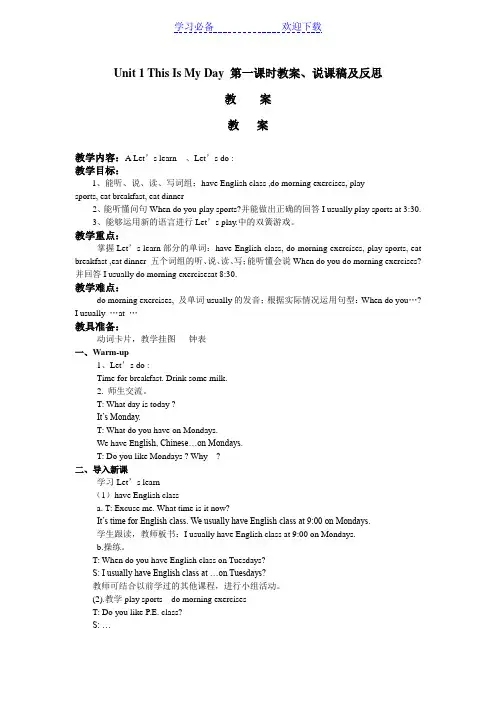
Unit 1 This Is My Day 第一课时教案、说课稿及反思教案教案教学内容:A Let’s learn 、Let’s do :教学目标:1、能听、说、读、写词组:have English class ,do morning exercises, playsports, eat breakfast, eat dinner2、能听懂问句When do you play sports?并能做出正确的回答I usually play sports at 3:30.3、能够运用新的语言进行Let’s play.中的双簧游戏。
教学重点:掌握Let’s learn部分的单词:have English class, do morning exercises, play sports, eat breakfast ,eat dinner 五个词组的听、说、读、写;能听懂会说When do you do morning exercises? 并回答I usually do morning exercisesat 8:30.教学难点:do morning exercises, 及单词usually的发音;根据实际情况运用句型:When do you…?I usually …at …教具准备:动词卡片,教学挂图钟表一、Warm-up1、Let’s do :Time for breakfast. Drink some milk.2. 师生交流。
T: What day is today ?It’s Monday.T: What do you have on Mondays.We have E nglish, Chinese…on Mondays.T: Do you like Mondays ? Why ?二、导入新课学习Let’s learn(1)have English classa. T: Excuse me. What time is it now?It’s time for English class. We usually have English class at 9:00 on Mondays.学生跟读,教师板书:I usually have English class at 9:00 on Mondays.b.操练。
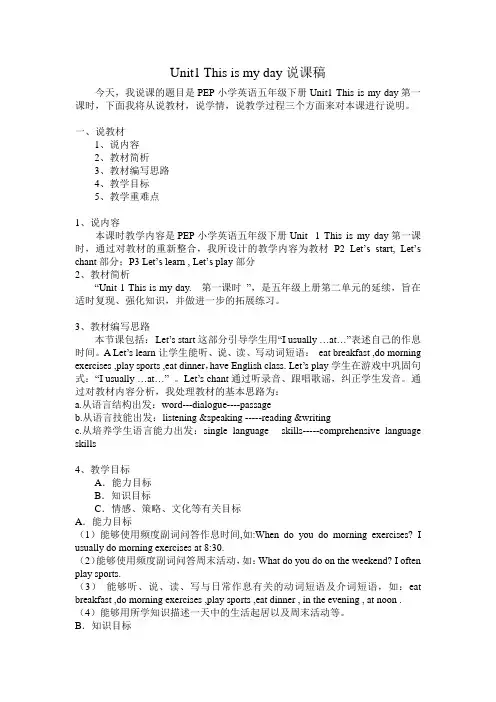
Unit1 This is my day说课稿今天,我说课的题目是PEP小学英语五年级下册Unit1 This is my day第一课时,下面我将从说教材,说学情,说教学过程三个方面来对本课进行说明。
一、说教材1、说内容2、教材简析3、教材编写思路4、教学目标5、教学重难点1、说内容本课时教学内容是PEP小学英语五年级下册Unit 1 This is my day第一课时,通过对教材的重新整合,我所设计的教学内容为教材P2 Let’s start, Let’s chant部分;P3 Let’s learn , Let’s play部分2、教材简析“Unit 1 This is my day. 第一课时”,是五年级上册第二单元的延续,旨在适时复现、强化知识,并做进一步的拓展练习。
3、教材编写思路本节课包括:Let’s start这部分引导学生用“I usually …at…”表述自己的作息时间。
A Let’s learn让学生能听、说、读、写动词短语:eat breakfast ,do morning exercises ,play sports ,eat dinner,have English class. Let’s play学生在游戏中巩固句式:“I usually …at…”。
Let’s chant通过听录音、跟唱歌谣,纠正学生发音。
通过对教材内容分析,我处理教材的基本思路为:a.从语言结构出发:word---dialogue----passageb.从语言技能出发:listening &speaking -----reading &writingc.从培养学生语言能力出发:single language skills-----comprehensive language skills4、教学目标A.能力目标B.知识目标C.情感、策略、文化等有关目标A.能力目标(1)能够使用频度副词问答作息时间,如:When do you do morning exercises? I usually do morning exercises at 8:30.(2)能够使用频度副词问答周末活动,如:What do you do on the weekend? I often play sports.(3)能够听、说、读、写与日常作息有关的动词短语及介词短语,如:eat breakfast ,do morning exercises ,play sports ,eat dinner , in the evening , at noon . (4)能够用所学知识描述一天中的生活起居以及周末活动等。
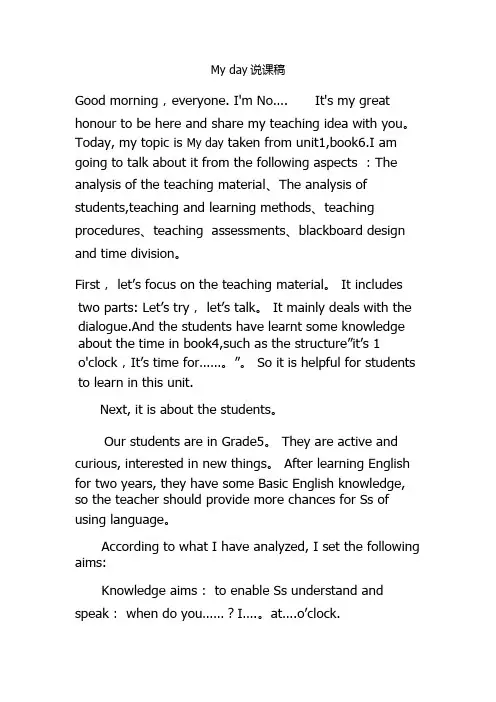
My day说课稿Good morning,everyone. I'm No…. It's my great honour to be here and share my teaching idea with you。
Today, my topic is My day taken from unit1,book6.I am going to talk about it from the following aspects :The analysis of the teaching material、The analysis of students,teaching and learning methods、teaching procedures、teaching assessments、blackboard design and time division。
First, let’s focus on the teaching material。
It includes two parts: Let’s try,let’s talk。
It mainly deals with the dialogue.And the students have learnt some knowledge about the time in book4,such as the structure”it’s 1o'clock,It’s time for……。
”。
So it is helpful for students to learn in this unit.Next, it is about the students。
Our students are in Grade5。
They are active and curious, interested in new things。
After learning English for two years, they have some Basic English knowledge, so the teacher should provide more chances for Ss of using language。
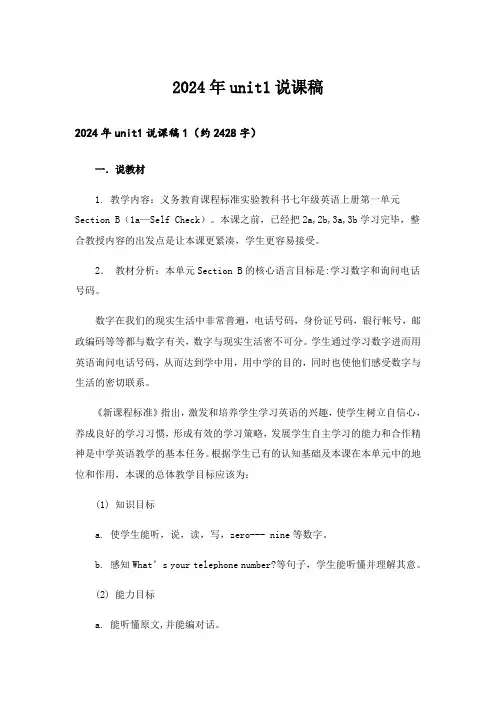
2024年unit1说课稿2024年unit1说课稿1(约2428字)一.说教材1. 教学内容:义务教育课程标准实验教科书七年级英语上册第一单元Section B(1a—Self Check)。
本课之前,已经把2a,2b,3a,3b学习完毕,整合教授内容的出发点是让本课更紧凑,学生更容易接受。
2.教材分析:本单元Section B的核心语言目标是:学习数字和询问电话号码。
数字在我们的现实生活中非常普遍,电话号码,身份证号码,银行帐号,邮政编码等等都与数字有关,数字与现实生活密不可分。
学生通过学习数字进而用英语询问电话号码,从而达到学中用,用中学的目的,同时也使他们感受数字与生活的密切联系。
《新课程标准》指出,激发和培养学生学习英语的兴趣,使学生树立自信心,养成良好的学习习惯,形成有效的学习策略,发展学生自主学习的能力和合作精神是中学英语教学的基本任务。
根据学生已有的认知基础及本课在本单元中的地位和作用,本课的总体教学目标应该为:(1) 知识目标a. 使学生能听,说,读,写,zero--- nine等数字。
b. 感知What’s your telephone number?等句子,学生能听懂并理解其意。
(2) 能力目标a. 能听懂原文,并能编对话。
b. 能扩展句型: What’s your/his/her telephone number?(3)情感目标a. 进一步提高学生对英语的学习热情,使学生树立学习英语的自信心 ,并培养学生观察和主动竞争的意识。
b. 培养学生积极主动地参与课堂活动,大胆开口,主动模仿,并培养学生的合作交流能力和欣赏美,评价美的能力。
(4) 本课的重点和难点:a. 重点:学习并掌握词汇 zero one two three four five six seven eight nine telephone number it phoneb.难点:询问电话号码的句型及回答: What’s your telephone number? It’s …/My telephone number is ……(5)教具准备:录音机,磁带,图片。
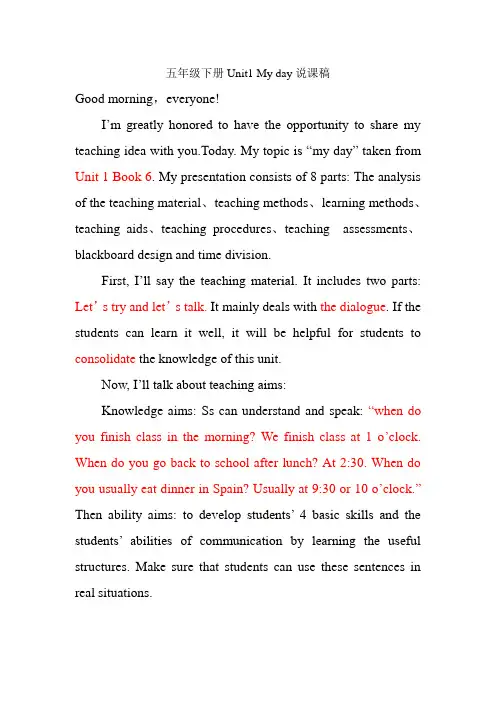
五年级下册Unit1 My day说课稿Good morning,everyone!I’m greatly honored to have the opportunity to share my teaching idea with you.Today. M y topic is “my day” taken from Unit 1 Book 6. My presentation consists of 8 parts: The analysis of the teaching material、teaching methods、learning methods、teaching aids、teaching procedures、teaching assessments、blackboard design and time division.First, I’ll say the teaching material.It includes two parts: Let’s try and let’s talk. It mainly deals with the dialogue. If the students can learn it well, it will be helpful for students to consolidate the knowledge of this unit.Now, I’ll talk about teaching aims:Knowledge aims: Ss can understand and speak: “when do you finish class in the morning? We finish class at 1 o’clock. When do you go back to school after lunch? At 2:30. When do you usually eat dinner in Spain? Usually at 9:30 or 10 o’clock.”Then ability aims: to develop students’ 4 basic skills and the students’ abilities of communication by learning the useful structures. Make sure that students can use these sentences in real situations.Moral aims: to arouse the students’ interests in learning English and enable students to study in groups and cooperate skillfully.Next, Important points and Difficult points. I think important points are Ss understand the meaning of the sentences.Difficult points are let’s try part and how to use these sentences in real situation.Secondly, it is about the students.Our students are in Grade5. They are active and curious, interested in new things. After learning English for 2 years, they have some Basic English knowledge, so the teacher should provide more chances for Ss of using language.As for teaching methods: To accomplish the teaching aims, I'll adopt communicative teaching method、Task-based teaching method and TPR. In this lesson, I'll use a tape-recorder, PPT, some pictures as teaching aids.Then, I'll say the learning methods: teach the students how to be successful English learners and let the students study by observation-imitation-practice, at the same time, independent learning and cooperative learning are necessary.Next, let's come to the Teaching procedures:I'll use the following five steps.Step one Warming-upI'll lead in today's topic by a song: Let the students listen and sing.And then make some free talks with the students. For example, I will present a picture of my timetable and talk about it. T: Hi, boys and girls, this is my timetable. Look, I get up at 7o’clock. How about you? Sarah, please. S: I get up at 6: 30. T: wow. How about you, Mike? M: I get up at 7:30. At last, I will divide the Ss into two groups, group 1 and group 2; see which group performs better according to their singing and action.The purpose is to form a better English learning surrounding for the students, and at the same time, it provides situations to review the learnt knowledge.Step two Presentation (it includes 2 tasks)Task1: listen and finish let’s tryFirst, I will present a picture in “Let’s try” and guide Ss to talk about it. For example, look at the pictures. There are three places: a playground, a classroom, a house. You can guess where are Zhangpeng and Pedro? (这是书上的问题)Ss will discuss about it. Then, let Ss listen to the tape and answer the question. After first time listening, I will give Ss the important sentences. Ss listen again and check the answer. Then, I will present the script of the dialogue and explain it to Ss. Ss listen againwithout the script.The purpose is to arouse Ss’interest in this class and present the new material.Task2.This is our new friend, Pedro. He is from Spain. Zhangpeng is curious about him. So Zhangpeng asks Pedro about his timetable: when do you finish class in the morning? When do you go back to school after lunch? When do you usually eat dinner in Spain? I will play the tape of let’s talk. Ss can make notes when they are listening. After listening, I will use PPT to present the whole dialogue and check the answer. We finish class at 1 o’clock. At 2:30. Usually at 9:30 or 10 o’clock. Then I will teach Ss about the word: usually, often, and sometimesSs listen again and read after the tape then read by themselves. At last, let Ss to complete the form with me.The purpose is to help the students to get the main idea of sentences and enhance their English listening skills.Step three. Practice (it includes 3 activities).Activity1: pair workSs work in pairs: one acts zhangpeng, another acts Pedro. Let Ss practice the dialogue in let’s talk. After three minutes, let Ss raise hands to act out the dialogue. The voluntary pair can get one point for themselves.Activity2: role playSs work in pairs. Let Ss practice the dialogue in role play. Each student chooses a picture. And then talk about it.When do you get up? I often get up at 5o’clock.When do you eat lunch? I often eat lunch at 12o’clock.Then, let volunteers to act out their dialogue and they can also get one point for themselves.Activity 3: describe your dayLet students work in pairs. And describe his day to the partner. They can describe like this: I get up at 6:00. I eat breakfast at 7:30.The purpose is to attract the students’ attentions andconsolidate the dialogue, so that they can participate in my class and study actively,it is also helpful to improve their spoken English.Step four Consolidation and extension.Make a dialogue. Let Ss make new dialogue modeled after let’s talk. For example, Amy is asking Sarah’s daily life. So Ss can make new dialogue like this: when do you go to school? I often go to school at 8o’clock.The purpose is to help Ss consolidate the knowledge they learnt today.Step five Summary and homework.Help the students to summarize what they learnt today. Let students complete the workbook exercises and interview more students to talk about their teachers.Now, I’ll say the teaching assessments.I’ll use Self–assessments, the group members’ assessments, a nd the teacher’s assessment. At the end of the class, I will check which group gets the most points.Finally, Blackboard design and time division.This is topic; I’ll divide the blackboard into two parts.In the middle of the blackboard, I’ll write some new sentences and mind map. On the either side of the blackboard, I’ll write thescores of each group.Time division: Warming–up(5minutes); Presentation(15minuties); Practice(13 minutes); Consolidation and extension (5 minutes) summary and homework (2 minutes).As far as I am concerned, a teacher is not only a guide for the students, but also a friend of them. If I were a teacher, I would change the traditional relationship between teachers and students and help them not only on their study, but also on their lives. I’m sure I can be a good teacher. Thank you for your attention.。
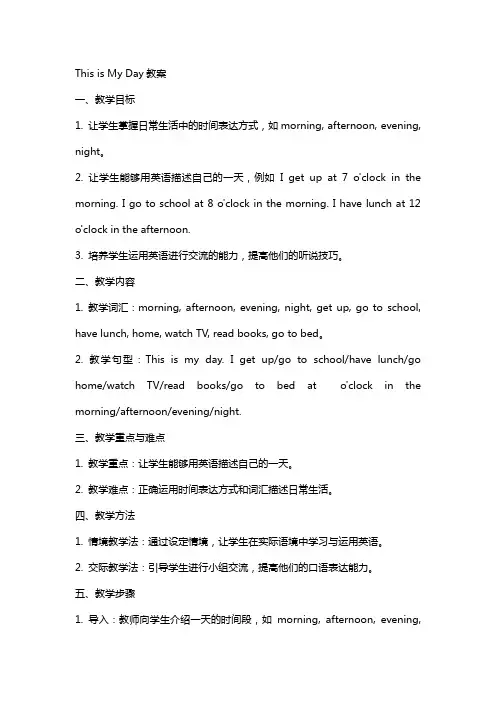
This is My Day教案一、教学目标1. 让学生掌握日常生活中的时间表达方式,如morning, afternoon, evening, night。
2. 让学生能够用英语描述自己的一天,例如I get up at 7 o'clock in the morning. I go to school at 8 o'clock in the morning. I have lunch at 12 o'clock in the afternoon.3. 培养学生运用英语进行交流的能力,提高他们的听说技巧。
二、教学内容1. 教学词汇:morning, afternoon, evening, night, get up, go to school, have lunch, home, watch TV, read books, go to bed。
2. 教学句型:This is my day. I get up/go to school/have lunch/go home/watch TV/read books/go to bed at o'clock in the morning/afternoon/evening/night.三、教学重点与难点1. 教学重点:让学生能够用英语描述自己的一天。
2. 教学难点:正确运用时间表达方式和词汇描述日常生活。
四、教学方法1. 情境教学法:通过设定情境,让学生在实际语境中学习与运用英语。
2. 交际教学法:引导学生进行小组交流,提高他们的口语表达能力。
五、教学步骤1. 导入:教师向学生介绍一天的时间段,如morning, afternoon, evening,night,并让学生用中文描述自己的一天。
2. 新课内容:教师展示图片,教授词汇morning, afternoon, evening, night,并引导学生用英语描述自己的一天。
小学英语说课稿《This is my day》(Section B)Good morning, dear judges. I’m No 5 candidate applying for primary school English teacher. Today my topic is Unit 1 This is my day. My presentation can be divided into the following six aspects: analysis of teaching materials, analysis of students, teaching methods, learning methods, teaching procedures and blackboard design. Now, I will present them one by one.Part One: Analysis of the Teaching MaterialThis class is the second period of Section B, Unit 1, primary school English book 6, PEP. This class is mainly about Ss’ activities on a day.It’s closely related to Ss’ real life. So Ss can learn it easily and happily. Based on the analysis of the teaching material, I set up the following three objectives:1.Knowledge objectivesKnowledge objective: Students can write and say key phrases: go hiking, go shopping, play the piano and so on.2. Ability objectivesSo can use the sentence patterns “What do you do on the weekend?” "I often ..."Cultivate their ability of speaking and listening.3.Emotional objectivesTo arouse the Ss’ interests in English.According to the new curriculum standard, the teaching key points and teaching difficult points are as follows:1.Key points:Master the new phrases: go hiking, go shopping, play the piano and so on.2.Difficult points:Ss master the use of sentence patterns “What do you do on the weekend?” "I often..." in the real situation.Part Two: Analysis of the studentsIn order to make Ss the real masters of the class, now I will analyzemy Ss. Ss in Grade 5 have learnt English for more than 2 years. They have accumulated some basic English knowledge. They have curiosity about English and they are willing to speak English. They can do some actions under the teacher's guidance, but they can't use English flexibly. Their abstract thinking is still not fully mature; their image thinking occupies an important position in learning. Pupils are emulative and active, and have strong collective sense of honor. I will take all these factors into consideration.Part Three: The Teaching MethodsIn order to break through the key points and difficult points,task-based language method, situational teaching method and TPR method will be adopted to finish my teaching. These teaching methodswill help attract Ss’ interest to the class.Part Four: The Learning MethodsThe students will adopt the corresponding learning methods ,such as Group competition\pair work\Individual work, through perception、participation、experience、cooperation、exploration、observation、generalization practice ,they can improve the comprehensive language usage ability.Part Five: Teaching ProceduresNext comes the most important part of my presentation, teaching procedure. Based on Students' physiological and psychological characteristics, I design the following teaching procedure.1. lead inAfter daily greetings,I will show the Ss some pictures of lovelycartoon characters, and talk about what they are doing with Ss. This step helps Ss review what they have learnt last period.2. presentation(1) Ss will listen to the tape and finish part 1 on page 8 by themselves, and then I will check their answers.(2) I will read the dialogue to my Ss and encourage them to read after me sentence by sentence. If I read in a high voice, Ss will read in a low voice. If I read in a low voice, Ss will read it in a high voice.(3) I will invite one student to be the little teacher and he teaches theother Ss to read the dialogue. If I put up my right hand, only the boys read after me. If I put up my left hand, only the girls read after me. I will correct their pronunciation.3. practice(1)Pair work: Ss role-play the dialogue with their partners. One isChen Jie and the other is John, then they exchange. Then some pairs will be invited to act it out in front of the class.(2)Group work: Ss work in a group of 6 to find out a friend you canplay with on the weekend. The some group leader will report their result to the class. Thus Ss’ communicative skills will be improved.3. summaryAsk Ss to sum up what they have learned today by themselves, and Iwill make an assessment.4. homeworkAsk Ss to write down a short passage about what they do on weekends.Part Six: Design of the blackboardLast but not least, I will talk about my blackboard design. I write thekey words and sentence pattern on the blackboard, in order to make Ss remember the key points more easily。
Unit 1 My day Part A Let’s talk一、教材分析本课程是人教PEP版英语五年级下册的Unit 1 My day Part A Let’s talk 部分,是本单元的重要组成部分,围绕着家庭生活的主题进行展开。
本部分主要通过三个场景对话,给孩子们介绍日常学习生活中的活动,并培养孩子们的听、说、读、写的能力,同时提高孩子们的情感认知和交际能力。
二、教学目标1. 知识目标•能熟练掌握本节课的生词和句型;•能正确理解并模仿对话中的语句;•能独立完成练习册的相关练习。
2. 能力目标•能够流利地表达日常活动,并与同伴进行交流;•能够进行分角色对话练习;•能够熟练运用单词和句型进行简单的口语交流。
3. 情感目标•通过对话培养孩子们的情感认知和分析能力;•促进孩子们的思维活跃,开拓视野,提高孩子们的学习兴趣;•培养孩子们的合作意识,增强孩子们的团队精神。
三、教学重难点1. 教学重点•通过对话介绍生活中的活动,引导学生积极开展日常学习和生活;•培养学生的听、说、读、写的能力,并提高其实践能力;•将单词和句型运用到实际口语交流中。
2. 教学难点•引导学生进行角色模拟对话;•培养学生较强的听力理解能力,面对困难时不灰心丧气,具有一定的抗压能力。
1. 创设情境,导入新课教师展示图片,激发学生对日常活动的兴趣和思考,并启发学生对话的意识。
2. 呈现教学内容2.1 Listen and repeat教师播放单词和句型,并呈现在白板上,让学生听读并模仿。
2.2 Let’s talk教师布置任务,分成小组进行角色模拟对话训练,其中教师可按角色分配学生。
2.3 Act out对每组同学进行评分并进行评价,最后选出最佳表现的组别。
3. 拓展练习通过练习册让学生巩固所学知识点。
4. 总结反馈教师对所学内容进行总结,并针对学生的表现给予评价,同时指出需要加强的地方。
五、板书设计Listen and repeat:1. brush teeth2. watch TV3. go to schoolLet's talk:- What do you do in the morning?- I brush my teeth.- What do you do in the evening?- I watch TV.Act out:A: What do you do in the morning?B: I brush my teeth.A: What do you do in the evening?B: I watch TV....1. 测评方式•学生观看、听取教师的讲解和解释,是否能准确地理解课文内容;•学生在角色模拟对话中发挥的积极性和表现力以及在口语交流中的应用情况;•学生在完成练习册练习的情况。
《This Is My Day》教案优秀设计一个好的教学设计是一节课成败的关键,要根据不同的课题进行灵活的教学设计。
首先对每一个课题的教学内容要有一个整体的把握。
下面就是小编给大家带来的《This Is My Day》教案,希望能帮助到大家!《This Is My Day》教案(一)教学目标1. 能听懂Let’s try部分的内容,并勾选出正确的图片。
2. 听、读Let’s talk部分,运用核心句子“When do you finish your class in the morning?”“We finish class at 1 o’clock.”来谈论时间,并变换单词,分角色练习对话。
教学重难点Important &difficult points(重难点)1. 掌握句型“When do you finish your class in the morning?”并能做出正确回答。
2. 能灵活运用“When do you usually eat dinner/…”“Usually at…o’clock.”问答作息时间。
教学工具课件教学过程Step1 : 预习温故(用时6分钟)1. Review “Times”(板书时间,让学生用英语说一说):10:00/6:00/9:00/…2. Review the phrases.do morning exercises —I do morning exercises at 6:00 a.m.用同样方法复习:eat breakfast、play sports、have Chinese/English class、eat dinner3. Guess the phrase(看动作),complete the dialogue:T: When do you do morning exercises/…? (板书) Ss: At … o’clock.反复操练此句型。
人教PEP版英语五下Unit 1《My day》说课稿一. 教材分析《人教PEP版英语五下Unit 1 My day》的主要内容是关于学生们日常生活的介绍。
通过本节课的学习,学生们能够掌握关于日常活动的一些关键词汇,如:watch TV, read books, do homework等,并且能够运用这些词汇进行简单的日常交流。
本节课的主题贴近学生的生活,有利于激发学生的学习兴趣,提高他们的学习积极性。
二. 学情分析五年级的学生已经具备了一定的英语基础知识,对于日常生活中的某些活动他们已经能够用英语进行简单的表达。
但是,对于一些复杂的日常活动,如“做手工”等,他们可能还不知道如何用英语表达。
因此,在教学过程中,我们需要关注学生的个体差异,因材施教,使每个学生都能在课堂上得到充分的锻炼。
三. 说教学目标1.知识目标:学生能够掌握本节课的主要词汇和句型,如:watch TV,read books, do homework等,并能够运用它们进行简单的交流。
2.能力目标:通过小组合作,学生能够用英语描述自己的日常生活,提高他们的口语表达能力。
3.情感目标:培养学生热爱生活,积极乐观的人生态度。
四. 说教学重难点1.重点:学生能够掌握本节课的主要词汇和句型,并能够运用它们进行简单的交流。
2.难点:学生能够用英语描述自己的日常生活,特别是对于一些复杂的日常活动,如“做手工”等,能够准确地用英语表达。
五. 说教学方法与手段在本节课的教学过程中,我将采用任务型教学法,通过设置各种任务,让学生在实践中学习英语,提高他们的口语表达能力。
同时,我还将运用多媒体教学手段,如图片、视频等,激发学生的学习兴趣,帮助他们更好地理解课文内容。
六. 说教学过程1.热身(5分钟):通过与学生谈论他们最喜欢的日常活动,激发学生的学习兴趣,引入本节课的主题。
2.呈现(10分钟):通过展示图片和视频,引导学生说出本节课的主要词汇和句型。
Unit 1 My Day 第六课时(说课稿)一、教材分析•课程教材:2022-2023学年英语五年级下册•本课时主题:谈论日常活动•语法重点:现在进行时态•目标语言:What are you doing? I’m [doing sth.].二、教学重点及难点1. 教学重点•了解现在进行时态的基本形式和用法;•学会询问和回答“你在做什么?”;•通过谈论自己的日常活动提高学生的口语表达能力。
2. 教学难点•现在进行时态的使用,需要进行语法解释和示范;•需要提供充足的语言输入和练习机会,帮助学生增强语感和运用能力。
三、教学过程设计1. 导入(5分钟)通过音乐或图片等方式引入本课主题,激发学生对日常活动的兴趣和好奇心,为新知识的学习做好铺垫。
2. 语言输入与解释(10分钟)•通过图片或PPT展示现在进行时态的基本形式和用法,并进行简要的语法解释;•向学生提供一些现在进行时态的例句,让他们理解句子结构和含义。
3. 示例演示(10分钟)组织教师和学生进行互动示范,通过提问学生并回答的方式展示现在进行时态的用法。
如:•Teacher: What are you doing?•Student: I’m reading a book.然后由学生之间互相提问、回答“你在做什么?”的练习。
4. 练习巩固(20分钟)•学生分组,每组4人;•给学生一张练习卷,在规定时间内完成;•完成后给同学互改并讲评,纠正错词错句并提供表扬和建议。
5. 总结(5分钟)复述本课时要点,并给出下节课作业。
四、板书设计1. 词汇板书现在进行时态相关单词:doing(v.), reading(v.), playing(v.), dancing(v.), singing (v.), listening(v.)2. 语法板书现在进行时态III Am/Is/Are + Verbing3. 句型板书询问句:What are you doing?回答句:I’m + [doing sth.]五、教学反思本节课的教学方法将新知识的语法带入口语练习中,让学生在尝试运用新语言的同时提高口语表达能力。
Unit 1 This is my day第四课时-教学教案一、教学重点:把握五个四会动词短语:climb mountains,go shopping,play the piano,visit grandparents,go hiking。
二.教学难点:单词mountain引导同学分音节仿照读音,把握拼写,强调字母组合ou发[au],ai发[ei]。
将单词grandparents分为grand和parents让同学把握。
三.教学预备:腾图资源的相关课件。
Let’s learn和Let’s sing的录音。
短语卡片:climb mountains,go shopping,play the piano,visit grandparents,go hiking。
父母及祖父母的照片。
四.教学过程:Review〔复习〕活动一复习句子教学参考时间:3-4分钟请同学分角色朗读Read and write局部对话。
老师提问:When do you... When do you ...... onSaturdays/Sundays请同学做出相应答复。
老师说:On Saturdays and Sundays,we don’t go to school. It is fun. OK,let’s listen to a song.复习本单元A局部内容,时间状语On Saturdays / Sundays的消灭可以以旧带新,为on the weekend的学习和使用进行铺垫,同时引起同学了解歌曲内容的古怪。
Warm up 〔热身〕活动二学唱歌曲教学参考时间:5分钟老师播放歌曲录音,同学观赏。
请同学说说在歌曲中听到的单词或短语。
老师说:From Friday evening to Sunday is weekend. 出示单词weekend,同学仿照发音。
老师说:On the weekend,we don’t go to school. What do we do on the weekend Let’s learn the song. 同学跟录音逐句学唱,老师适当用动作演示句子意思,挂念同学理解。
Unit 1 This is My Day说课稿
尊敬的评委老师,大家好!
今天我说课的内容是PEP小学英语五年级下册Unit 1 This is my day.A部分的第二课时。
下面我将从教材分析、教法学法指导、教学过程、板书设计和教学反思五个方面进行我的说课。
一、教材分析
1、教学内容分析
本单元围绕着“My day”这一核心话题来展开教学活动,主要学习有关日常作息时间的交际用语,对一天中的生活起居以及周末活动等进行简单描述。
本课时包括Let’s talk 和Let’s find out两部分,要求学生能够正确运用When do you get up/eat breakfast…?等询问作息时间,以及运用I usually get up at…等应答语。
学好本节课将为学生进一步运用When do you…?进行询问打下坚实的基础。
2、教学目标分析
英语新课程标准指出,基础教育阶段英语课程的总体目标是培养学生的综合语言运用能力。
我根据目标要求,对教学内容进行分析后,将本课时教学目标确定为以下三维目标:
(1).知识与技能目标
能够听、说、认读主要句型When do you get up/eat breakfast…?及答语I usually get up at…
能够正确使用usually,often,sometimes三个频度副词。
(2)方法与过程目标
(1)采用创设对话情景,在教师指导下以四人小组合作方式展开交流。
(2)采用闯关游戏形式,步步为营,层层突破,最终完成教学目标。
(3)情感与态度目标
培养学生养成规范的作息习惯,激发对英语的学习兴趣。
3、教学重难点分析
(1)本节课的教学重点是掌握句型When do you get up/eat breakfast…?及答语I usually get up at…
(2)教学难点是usually, often, sometimes三个频度副词的使用。
二.教法与学法指导
为了更好实现以上教学目标,根据五年级学生活泼好动,表现欲强的特点,我主要采用情境教学法、多媒体辅助教学、游戏教学法,小组活动学习法等多种教学方法,让学生在情景中了解语言,用游戏来突破本课重难点,并在老师的指导下在小组内用兵教兵,兵练兵的方法使每一个学生都得到发展,最终达到真正意义上的能力的提升。
三.教学过程
本着以学生为学习主体的原则,这节课我组织学生进行丰富的
语言实践活动,将教学过程分为四部分完成。
Step1 Warmming-up
由于本节课主要学习Let’s talk中的对话练习,在第一课时学生已经学习了eat breakfast等动词短语,对话主要是围绕这几个短语展开,因此让学生复习巩固尤为重要。
我主要让学生听录音,跟读Let’s learn 部分并拼写动词短语。
Step2 Presentation and practice
在这一环节中,我设计游戏闯关的形式,充分发挥学生学习的主体性。
第一关:自主学习,挑战自我。
让学生自读对话一遍,总体感知对话的大意。
第二关:听力训练,纠正发音。
(1)在了解对话大意的前提下,完整听录音一遍;
(2)第二遍听录音并跟读。
第三关:合作学习,互助提高。
(1)小组合作学习。
在组长的指导下勾画重点句子,并着采用组长问、组员
答,组员互问互答的方式操练这些句型。
如发现仍不会的同学,请求老师指导。
(2)请2个小组示范读,然后由组长带全班读。
第四关:拓展训练,展示自我。
(1)角色扮演:以小组为单位,由小组长带领组员朗读对话。
(2)情景交际:让孩子自创对话情景,自编对话,练习并表演。
(3)超越自我,上台展示。
我将教室的一角布置成家庭餐厅,用学生的桌椅板凳做成餐桌,布置场景,学生在情景内自由表演对话。
这充分发挥学生主动性和创造性。
Step3 Summary
(1)学生自我总结,本节课我学会了······,并大胆说出自己的收获。
(2)给闯关成功者和表演优秀者奖励。
Step4 Homework
回家后让学生询问一下父母一天的时间安排,做一份timetable。
四、板书设计
在板书设计上,我采用句型和短语的分层次呈现,既简洁明了,又干净整洁,使人看了一目了然,有呈现,有操练,又能体现本课的重难点内容,最后达到寓乐于学的效果。
五、教学反思
在设计这堂课时,我尽可能地采用听、说、游戏的方式,通过各个有趣、实用、轻松、活泼的闯关活动,让学生在玩中学,学中用,逐步解决本课的重、难点,提高了课堂实效,培养了学生学习的兴趣。
我相信通过让学生主体参与、体验感悟、游戏巩固,一定能圆满实现课堂教学任务。
当然,由于自己水平有限,各个环节之间还存在着很多缺点和不足,愿各位老师提出宝贵的意见和建议。
以上就是我全部的说课内容,非常感谢各位评委的倾听,谢谢!。